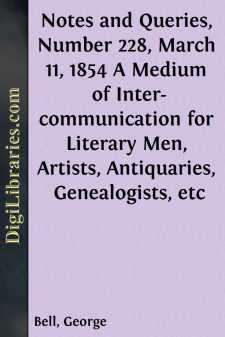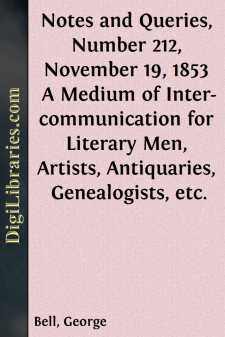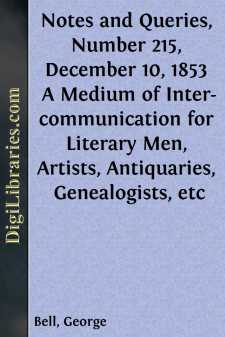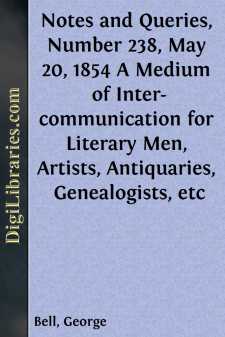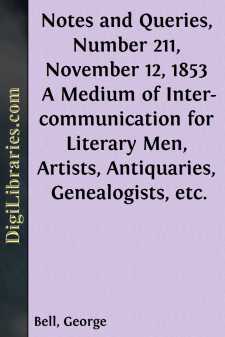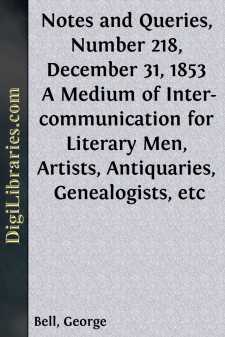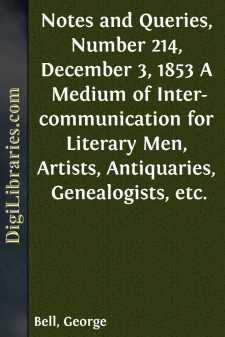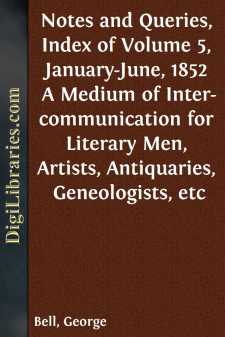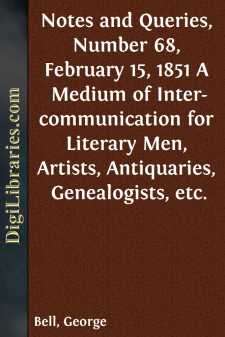Categories
- Antiques & Collectibles 13
- Architecture 36
- Art 48
- Bibles 22
- Biography & Autobiography 813
- Body, Mind & Spirit 142
- Business & Economics 28
- Children's Books 16
- Children's Fiction 13
- Computers 4
- Cooking 94
- Crafts & Hobbies 4
- Drama 346
- Education 46
- Family & Relationships 57
- Fiction 11829
- Games 19
- Gardening 17
- Health & Fitness 34
- History 1377
- House & Home 1
- Humor 147
- Juvenile Fiction 1873
- Juvenile Nonfiction 202
- Language Arts & Disciplines 88
- Law 16
- Literary Collections 686
- Literary Criticism 179
- Mathematics 13
- Medical 41
- Music 40
- Nature 179
- Non-Classifiable 1768
- Performing Arts 7
- Periodicals 1453
- Philosophy 64
- Photography 2
- Poetry 896
- Political Science 203
- Psychology 42
- Reference 154
- Religion 513
- Science 126
- Self-Help 84
- Social Science 81
- Sports & Recreation 34
- Study Aids 3
- Technology & Engineering 59
- Transportation 23
- Travel 463
- True Crime 29
Notes and Queries, Number 197, August 6, 1853 A Medium of Inter-communication for Literary Men, Artists, Antiquaries, Genealogists, etc.
by: George Bell
Categories:
Description:
Excerpt
HIGH CHURCH AND LOW CHURCH.
A Universal History of Party; with the Origin of Party Names
would form an acceptable addition to literary history: "N. & Q." has contributed towards such a work some disquisitions on our party namesWhigandTory, andThe Good Old Cause. Such names asPuritan,Malignant,Evangelical, can be traced up to their first commencement, but some obscurity hangs on the mintage-date of the names we are about to consider.As a matter of fact, the distinction of High Church and Low Church always existed in the Reformed English Church, and the history of these parties would be her history. But the names were not coined till the close of the seventeenth century, and were not stamped in full relief as party-names till the first year of Queen Anne's reign.
In October, 1702, Anne's first Parliament and Convocation assembled:
"From the deputies in Convocation at this period, the appellations High Church and Low Church originated, and they were afterwards used to distinguish the clergy. It is singular that the bishops were ranked among the Low Churchmen (see Burnet, v. 138.; Calamy, i. 643.; Tindal's Cont., iv. 591.)"—Lathbury's Hist. of the Convocation, Lond. 1842, p. 319.
Mr. Lathbury is a very respectable authority in matters of this kind, but if he use "originated" in its strict sense, I am inclined to think he is mistaken; as I am tolerably certain that I have met with the words several years before 1702. At the moment, however, I cannot lay my hands on a passage to support this assertion.
The disputes in Convocation gave rise to a number of pamphlets, such as A Caveat against High Church, Lond. 1702, and The Low Churchmen vindicated from the unjust Imputation of being No Churchmen, in Answer to a Pamphlet called "The Distinction of High and Low Church considered:" Lond. 1706, 8vo. Dr. Sacheverell's trial gave additional zest to the dudgeon ecclesiastick, and produced a shower of pamphlets. I give the title of one of them: Pulpit War, or Dr. S——l, the High Church Trumpet, and Mr. H——ly, the Low Church Drum, engaged by way of Dialogue, Lond. 1710, 8vo.
To understand the cause of the exceeding bitterness and virulence which animated the parties denominated High Church and Low Church, we must remember that until the time of William of Orange, the Church of England, as a body—her sovereigns and bishops, her clergy and laity—comes under the former designation; while those who sympathised with the Dissenters were comparatively few and weak. As soon as William was head of the Church, he opened the floodgates of Puritanism, and admitted into the church what previously had been more or less external to it. This element, thus made part and parcel of the Anglican Church, was denominated Low Church. William supplanted the bishops and clergy who refused to take oaths of allegiance to him as king de jure; and by putting Puritans in their place, made the latter the dominant party. Add to this the feelings of exasperation produced by the murder of Charles I., and the expulsion of the Stuarts, and we have sufficient grounds, political and religious, for an irreconcilable feud....



